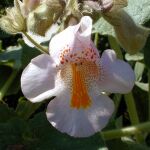| Drug Interactions: |
Ticlopidine, Warfarin
| Taking devil's claw with these drugs may increase the risk of bleeding or bruising: |
| Abciximab, (ReoPro) |
Aspirin, (Bufferin, Ecotrin) |
Celecoxib, (Celebrex) |
Enoxaparin, (Lovenox) |
| Etodolac, (Lodine, Utradol) |
Heparin, (Hepalean, Hep-Lock) |
Ibuprofen, (Advil, Motrin) |
Indomethacin, (Indocin, Novo-Methacin) |
| Ketoprofen, (Orudis, Rhodis) |
Ketorolac, (Acular, Toradol) |
Meloxicam, (MOBIC, Mobicox) |
Naproxen, (Aleve, Naprosyn) |
| Piroxicam, (Feldene, Nu-Pirox) |
Rofecoxib, (Vioxx) |
Ticlopidine, (Alti-Ticlopidine, Ticlid) |
Urokinase, (Abbokinase) |
| Warfarin, (Coumadin, Jantoven) |
| Taking devil's claw with these drugs may interfere with the action of the drug: |
| Aluminum Hydroxide, (AlternaGel, AluCap) |
Aluminum Hydroxide and Magnesium Carbonate, (Gaviscon Extra Strength, Gaviscon Liquid) |
Aluminum Hydroxide and Magnesium Hydroxide, (Maalox, Rulox) |
Aluminum Hydroxide and Magnesium Trisilicate, (Gaviscon Tablet) |
| Aluminun Hydroxide, Magnesium Hydroxide, and Simethicone, (Maalox, Mylanta Liquid) |
Calcium Carbonate, (Rolaids Extra Strength, Tums) |
Calcium Carbonate and Magnesium Hydroxide, (Mylanta Gelcaps, Rolaids Extra Strength) |
Cimetidine, (Nu-Cimet, Tagamet) |
| Esomeprazole, (Nexium) |
Famotidine, (Apo-Famotidine, Pepcid) |
Famotidine, Calcium Carbonate, and Magnesium Hydroxide, (Pepcid Complete) |
Lansoprazole, (Prevacid) |
| Magaldrate and Simethicone, (Riopan Plus, Riopan Plus Double Strength) |
Magnesium Hydroxide, (Ducolax Milk of Magnesia, Phillip's Milk of Magnesia) |
Magnesium Oxide, (Mag-Ox 400, Uro-Mag) |
Magnesium Sulfate, (Epsom Salts) |
| Nizatidine, (Axis, PMS-Nizatidine) |
Omeprazole, (Losec, Prilosec) |
Pantoprazole, (Pantoloc, Protonix) |
Rabeprazole, (Aciphex, Pariet) |
| Ranitidine, (Alti-Ranitidine, Zantac) |
Sodium Bicarbonate, (Brioschi, Neut) |
| Taking devil's claw with these drugs may increase the risk of hypoglycemia (low blood sugar): |
| Acarbose, (Prandase, Precose) |
Acetohexamide, (Acetohexamide) |
Chlorpropamide, (Diabinese, Novo-Propamide) |
Gliclazide, (Diamicron, Novo-Gliclazide) |
| Glimepiride, (Amaryl) |
Glipizide, (Glucotrol) |
Glipizide and Metformin, (Metaglip) |
Gliquidone, (Beglynor, Glurenorm) |
| Glyburide, (DiaBeta, Micronase) |
Glyburide and Metformin, (Glucovance) |
Insulin, (Humulin, Novolin R) |
Metformin, (Glucophage, Riomet) |
| Miglitol, (Glyset) |
Nateglinide, (Starlix) |
Pioglitazone, (Actos) |
Repaglinide, (GlucoNorm, Prandin) |
| Rosiglitazone, (Avandia) |
Rosiglitazone and Metformin, (Avandamet) |
Tolazamide, (Tolinase) |
Tolbutamide, (Apo-Tolbutamide, Tol-Tab) |
| Taking devil's claw with these drugs may increase the risk of hypotension (excessively low blood pressure): |
| Acebutolol, (Novo-Acebutolol, Sectral) |
Amlodipine, (Norvasc) |
Atenolol, (Apo-Atenolol, Tenormin) |
Benazepril, (Lotensin) |
| Betaxolol, (Betoptic S, Kerlone) |
Bisoprolol, (Monocor, Zebeta) |
Bumetanide, (Bumex, Burinex) |
Candesartan, (Atacand) |
| Captopril, (Capoten, Novo-Captopril) |
Carteolol, (Cartrol, Ocupress) |
Carvedilol, (Coreg) |
Chlorthiazide, (Diuril) |
| Chlorthalidone, (Apo-Chlorthalidone, Thalitone) |
Clonidine, (Catapres, Duraclon) |
Diazoxide, (Hyperstat, Proglycem) |
Diltiazem, (Cardizem, Tiazac) |
| Doxazosin, (Alti-Doxazosin, Cardura) |
Enalapril, (Vasotec) |
Eplerenone, (Inspra) |
Eprosartan, (Teveten) |
| Esmolol, (Brevibloc) |
Felodipine, (Plendil, Renedil) |
Fenoldopam, (Corlopam) |
Fosinopril, (Monopril) |
| Furosemide, (Apo-Furosemide, Lasix) |
Guanabenz, (Wytensin) |
Guanadrel, (Hylorel) |
Guanfacine, (Tenex) |
| Hydralazine, (Apresoline, Novo-Hylazin) |
Hydrochlorothiazide, (Apo-Hydro, Microzide) |
Hydrochlorothiazide and Triamterene, (Dyazide, Maxzide) |
Indapamide, (Lozol, Nu-Indapamide) |
| Irbesartan, (Avapro) |
Isradipine, (DynaCirc) |
Labetalol, (Normodyne, Trandate) |
Lisinopril, (Prinivil, Zestril) |
| Losartan, (Cozaar) |
Mecamylamine, (Inversine) |
Mefruside, (Baycaron) |
Methyclothiazide, (Aquatensen, Enduron) |
| Methyldopa, (Apo-Methyldopa, Nu-Medopa) |
Metolazone, (Mykrox, Zaroxolyn) |
Metoprolol, (Betaloc, Lopressor) |
Minoxidil, (Loniten, Rogaine) |
| Moexipril, (Univasc) |
Nadolol, (Apo-Nadol, Corgard) |
Nicardipine, (Cardene) |
Nifedipine, (Adalat CC, Procardia) |
| Nisoldipine, (Sular) |
Nitroglycerin, (Minitran, Nitro-Dur) |
Nitroprusside, (Nipride, Nitropress) |
Olmesartan, (Benicar) |
| Oxprenolol, (Slow-Trasicor, Trasicor) |
Perindopril Erbumine, (Aceon, Coversyl) |
Phenoxybenzamine, (Dibenzyline) |
Phentolamine, (Regintine, Rogitine) |
| Pindolol, (Apo-Pindol, Novo-Pindol) |
Polythiazide, (Renese) |
Prazosin, (Minipress, Nu-Prazo) |
Propranolol, (Inderal, InnoPran XL) |
| Quinapril, (Accupril) |
Ramipril, (Altace) |
Reserpine, (Reserpine) |
Spironolactone, (Aldactone, Novo-Spiroton) |
| Telmisartan, (Micardis) |
Terazosin, (Alti-Terazosin, Hytrin) |
Timolol, (Betimol, Timoptic) |
Torsemide, (Demadex) |
| Trandolapril, (Mavik) |
Triamterene, (Dyrenium) |
Trichlormethiazide, (Metatensin, Naqua) |
Valsartan, (Diovan) |
| Verapamil, (Calan, Isoptin SR) |
|

